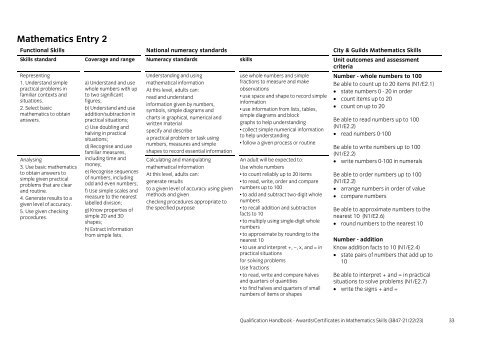Awards/certificates in mathematics skills (3847-21/22 ... - City & Guilds
Awards/certificates in mathematics skills (3847-21/22 ... - City & Guilds
Awards/certificates in mathematics skills (3847-21/22 ... - City & Guilds
Create successful ePaper yourself
Turn your PDF publications into a flip-book with our unique Google optimized e-Paper software.
Mathematics Entry 2<br />
Functional Skills National numeracy standards <strong>City</strong> & <strong>Guilds</strong> Mathematics Skills<br />
Skills standard Coverage and range Numeracy standards <strong>skills</strong> Unit outcomes and assessment<br />
criteria<br />
Represent<strong>in</strong>g<br />
1. Understand simple<br />
practical problems <strong>in</strong><br />
familiar contexts and<br />
situations.<br />
2. Select basic<br />
<strong>mathematics</strong> to obta<strong>in</strong><br />
answers.<br />
Analys<strong>in</strong>g<br />
3. Use basic <strong>mathematics</strong><br />
to obta<strong>in</strong> answers to<br />
simple given practical<br />
problems that are clear<br />
and rout<strong>in</strong>e.<br />
4. Generate results to a<br />
given level of accuracy.<br />
5. Use given check<strong>in</strong>g<br />
procedures.<br />
a) Understand and use<br />
whole numbers with up<br />
to two significant<br />
figures;<br />
b) Understand and use<br />
addition/subtraction <strong>in</strong><br />
practical situations;<br />
c) Use doubl<strong>in</strong>g and<br />
halv<strong>in</strong>g <strong>in</strong> practical<br />
situations;<br />
d) Recognise and use<br />
familiar measures,<br />
<strong>in</strong>clud<strong>in</strong>g time and<br />
money;<br />
e) Recognise sequences<br />
of numbers, <strong>in</strong>clud<strong>in</strong>g<br />
odd and even numbers;<br />
f) Use simple scales and<br />
measure to the nearest<br />
labelled division;<br />
g) Know properties of<br />
simple 2D and 3D<br />
shapes;<br />
h) Extract <strong>in</strong>formation<br />
from simple lists.<br />
Understand<strong>in</strong>g and us<strong>in</strong>g<br />
mathematical <strong>in</strong>formation<br />
At this level, adults can:<br />
read and understand<br />
<strong>in</strong>formation given by numbers,<br />
symbols, simple diagrams and<br />
charts <strong>in</strong> graphical, numerical and<br />
written material<br />
specify and describe<br />
a practical problem or task us<strong>in</strong>g<br />
numbers, measures and simple<br />
shapes to record essential <strong>in</strong>formation<br />
Calculat<strong>in</strong>g and manipulat<strong>in</strong>g<br />
mathematical <strong>in</strong>formation<br />
At this level, adults can:<br />
generate results<br />
to a given level of accuracy us<strong>in</strong>g given<br />
methods and given<br />
check<strong>in</strong>g procedures appropriate to<br />
the specified purpose<br />
use whole numbers and simple<br />
fractions to measure and make<br />
observations<br />
• use space and shape to record simple<br />
<strong>in</strong>formation<br />
• use <strong>in</strong>formation from lists, tables,<br />
simple diagrams and block<br />
graphs to help understand<strong>in</strong>g<br />
• collect simple numerical <strong>in</strong>formation<br />
to help understand<strong>in</strong>g<br />
• follow a given process or rout<strong>in</strong>e<br />
An adult will be expected to:<br />
Use whole numbers<br />
• to count reliably up to 20 items<br />
• to read, write, order and compare<br />
numbers up to 100<br />
• to add and subtract two-digit whole<br />
numbers<br />
• to recall addition and subtraction<br />
facts to 10<br />
• to multiply us<strong>in</strong>g s<strong>in</strong>gle-digit whole<br />
numbers<br />
• to approximate by round<strong>in</strong>g to the<br />
nearest 10<br />
• to use and <strong>in</strong>terpret +, –, x, and = <strong>in</strong><br />
practical situations<br />
for solv<strong>in</strong>g problems<br />
Use fractions<br />
• to read, write and compare halves<br />
and quarters of quantities<br />
• to f<strong>in</strong>d halves and quarters of small<br />
numbers of items or shapes<br />
Number - whole numbers to 100<br />
Be able to count up to 20 items (N1/E2.1)<br />
• state numbers 0 - 20 <strong>in</strong> order<br />
• count items up to 20<br />
• count on up to 20<br />
Be able to read numbers up to 100<br />
(N1/E2.2)<br />
• read numbers 0-100<br />
Be able to write numbers up to 100<br />
(N1/E2.2)<br />
• write numbers 0-100 <strong>in</strong> numerals<br />
Be able to order numbers up to 100<br />
(N1/E2.2)<br />
• arrange numbers <strong>in</strong> order of value<br />
• compare numbers<br />
Be able to approximate numbers to the<br />
nearest 10 (N1/E2.6)<br />
• round numbers to the nearest 10<br />
Number - addition<br />
Know addition facts to 10 (N1/E2.4)<br />
• state pairs of numbers that add up to<br />
10<br />
Be able to <strong>in</strong>terpret + and = <strong>in</strong> practical<br />
situations to solve problems (N1/E2.7)<br />
• write the signs + and =<br />
Qualification Handbook - <strong>Awards</strong>/Certificates <strong>in</strong> Mathematics Skills (<strong>3847</strong>-<strong>21</strong>/<strong>22</strong>/23) 33
















